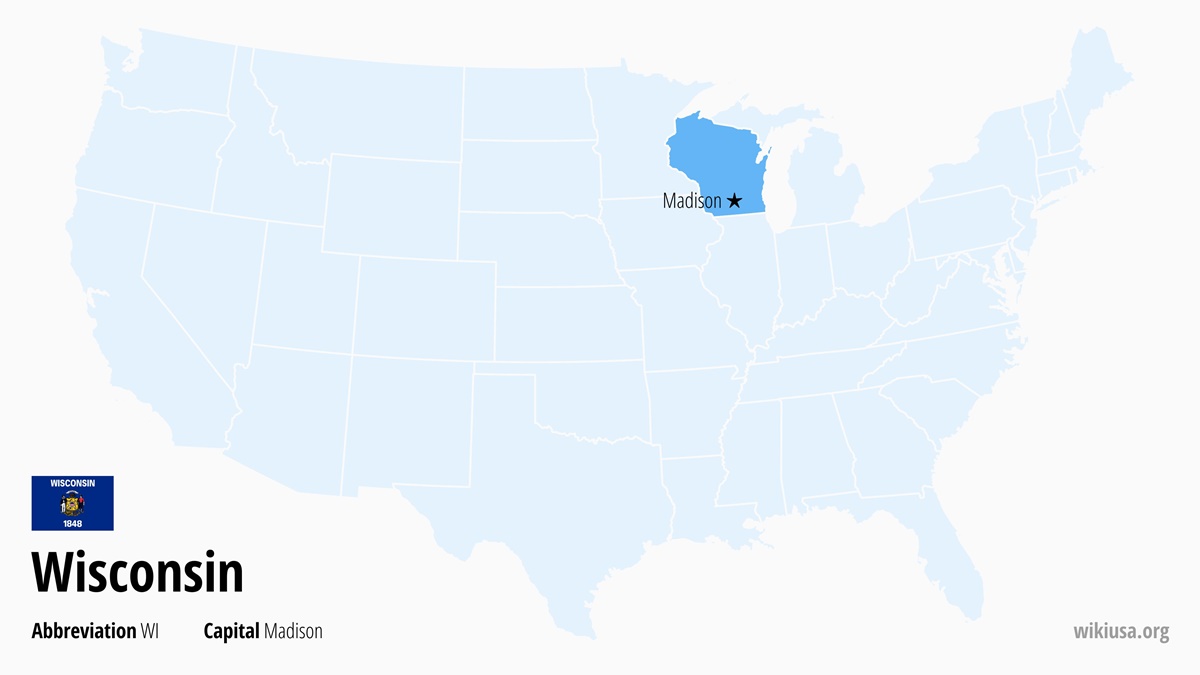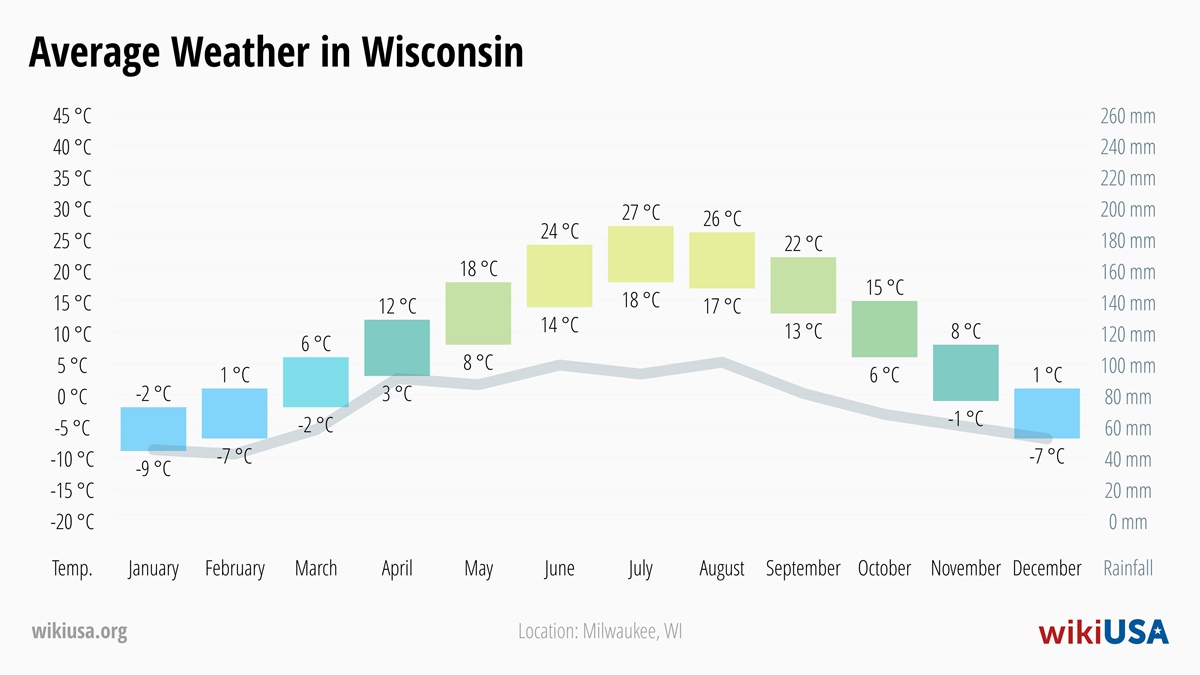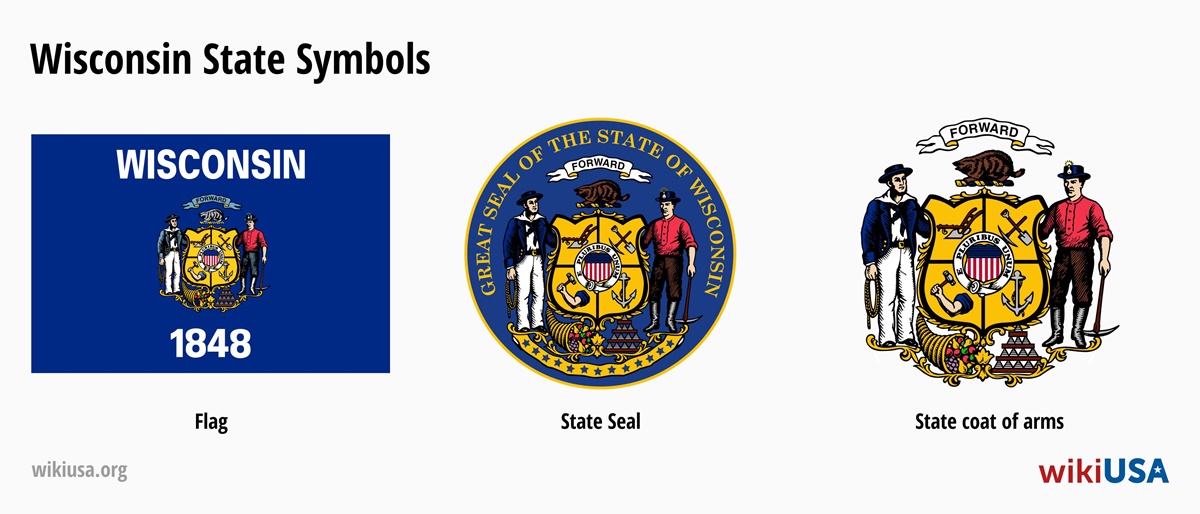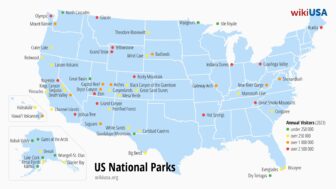Wisconsin (WI) is located in the American Midwest and stands out among other states for its significant milk and cheese production. Agriculture and food processing are the most important to the state’s economy, complemented by manufacturing and tourism. The capital of Wisconsin is Madison, with most people living in Milwaukee. In 1910, Emil Seidel was elected mayor of Milwaukee, becoming the first socialist mayor in a major American city.
-
Table of Contents
Quick Facts
Name Wisconsin Abbreviation WI Capital Madison Largest city Milwaukee (Population: 561 385) Current time 14:28 Time zone CST (UTC-6), the state observes daylight saving time CDT (UTC-5) Population 5,893,713 (#20 most populous US state) Area 65,498 sqmi (#23 largest US state) Admitted to the Union May 29, 1848 (#30 state to join) ⭐ Capital of Wisconsin
The capital of Wisconsin is Madison, whose history began in 1829 when former federal judge James Duane Doty purchased 2 sqmi of swampland and forest in the valley between Lakes Mendota and Monona. Judge Doty founded a new town there, which he later named after the fourth President of the United States, James Madison, who died on June 28, 1836. Madison first became the seat of the Territory of Wisconsin in 1838 and, after Wisconsin entered the Union in 1848, its capital.
🏙️ Largest City in Wisconsin
The largest city in Wisconsin is Milwaukee, with a population of 561,385 in 2023. In second place is the capital city of Madison with a population of 280,305 and in third place is Green Bay with 105,744 residents.
🕒 Time in Wisconsin
The current time in Wisconsin is 14:28. The state is governed by Central Standard Time (CST, UTC-6) and is always on Daylight Saving Time from the second Sunday in March to the first Sunday in November.
🧑🤝🧑 Population of Wisconsin
According to 2023 data, Wisconsin had a population of 5,893,713, ranking it 20th on the list of the most populous states in the USA.
📍 Area of Wisconsin
The total area of Wisconsin is 65,498 sqmi, of which 54,153 sqmi is land and 11,345 sqmi is water. Wisconsin is the 23rd largest US state.
-
Fun Facts About Wisconsin
🧩 Wisconsin Neighboring States
Wisconsin is bordered by four US states. To the west is Minnesota, to the north is Michigan, to the south is Illinois, and to the southeast is Iowa. The state’s eastern border is the shoreline of Lake Michigan and part of its northern border is Lake Superior.
📅 Date of Wisconsin Statehood
Wisconsin was admitted to the Union on May 29, 1848 as the 30th state in the order, its predecessor state being the Territory of Wisconsin.
📛 Nickname of the State of Wisconsin
Wisconsin is nicknamed “The Badger State” – but it’s not because badgers have overpopulated the state. The nickname originated in the 19th century, when the local economy was driven by mineral extraction, which brought immigrants from across the United States and Europe to Wisconsin. Some miners survived in holes dug in the ground “like badgers,” giving rise to the originally unflattering nickname.
The other nickname, “America’s Dairyland,” refers to the strong dairy industry in Wisconsin. America’s Dairyland produces about 25% of the total milk and cheese in the USA.
⛰️ Highest Mountain in Wisconsin
Wisconsin’s highest peak is with 1,951 ft Timms Hill, which has a wooden free-standing lookout tower.
🏞️ Rivers in Wisconsin
The longest river in Wisconsin is the Mississippi River with the total length of flow in all US states 2,318 mi. It is followed by the Wisconsin River (429 mi), Rock River (299 mi), Wolf River (225 mi), and Oconto River (209 mi).
🎓 Universities in Wisconsin
Wisconsin’s public universities are administered under one integrated system that includes about 161,000 students and thirteen campuses.
The largest in the state is the University of Wisconsin-Madison, founded in 1848 and now attended by around 50 thousand students.
The second largest university is the University of Wisconsin-Milwaukee with 23 thousand students and existing since 1956. The University of Wisconsin-Oshkosh, founded in 1871 and with over 16 000 students, rounds out the top three.
✉️ Wisconsin ZIP Codes
The state of Wisconsin has dedicated zip code ranges 530xx-532xx, 534xx-535xx and 537xx-549xx, searchable by address on the USPS website. For more information, see the article ZIP Codes in the USA.
-
Weather in Wisconsin
The best times to visit Wisconsin are spring and fall, when temperatures are milder than in the summer months and the state’s natural parks are less crowded.
Spring in Wisconsin is marked by changeable weather and rising temperatures. While temperatures in March still hover around 28 °F to 41 °F, by May they can reach 64 °F. With the cold weather comes snow showers, which gradually turn into rainfall.
Wisconsin summers are traditionally warm and humid, with temperatures typically around 72 °F to 81 °F. The rainiest months are July and August, when Wisconsin is a popular tourist destination.
Autumn in Wisconsin is cooler, with temperatures gradually dropping to 41 °F to 50 °F. Rainfall totals decrease, creating favorable conditions for travel.
Winter in Wisconsin is typically frigid, with temperatures generally below freezing and can drop to 14 °F. Snowfall is frequent, and heavy snowstorms are quite common.
🌡️ Average Temperatures and Precipitation in Wisconsin
-
Things to Do in Wisconsin
1️⃣ Apostle Islands National Seashore
The Apostle Islands National Seashore includes 21 islands in northern Wisconsin that are surrounded by wilderness. Visitors usually use a kayak to move between the islands, which allows them to explore the beauty of the sea caves.
Popular activities also include camping or boating, and in the winter it’s possible to explore breathtaking ice caves. The islands are also known as home to many lighthouses.
2️⃣ Noah’s Ark Waterpark
Noah’s Ark is the largest outdoor water world in the United States, located in the Wisconsin Dells northwest of Milwaukee. Visitors to the park can choose from approximately 50 slides, pools, water slides and other water attractions.
The biggest attraction is one of the longest water slides in America called the Black Anaconda, which is ridden on inflatable boats. The park offers plenty of fun for young children and is only open from May to September.
3️⃣ Cave of the Mounds
The landmarked Cave of the Mounds is described as the jewel of the Midwest, located in the southern part of the state west of Milwaukee. There are regular guided tours of the caves, during which you can see stalactites of many shapes, including narrow straws or helictites. The caves are open to visitors year-round, and children are welcome to visit.
4️⃣ Harley-Davidson Museum
The Harley-Davidson Museum in Milwaukee is a must-stop for all motorcycle fans. The museum displays more than 450 motorcycles, engines, fuel tanks and other artifacts from the brand’s rich history. Visitors can learn about the evolution of motorcycles and the entire Harley Davidson culture through interactive displays.
5️⃣ Devil’s Lake State Park
Devil’s Lake is the largest state park in Wisconsin, and visitors can hike 29.0 mi hiking trails with spectacular views of the lake and surrounding cliffs. The park also offers good conditions for rock climbing, swimming and picnicking, and several campsites are available for overnight stays. The state park is a good place to visit for families and groups of friends looking for active recreation.
6️⃣ National Railroad Museum
The National Railroad Museum in Green Bay in eastern Wisconsin is one of the top attractions for American train enthusiasts. The museum displays historic locomotives and cars, with some of the biggest draws including President Dwight D. Eisenhower’s 1937 train and one of the world’s largest steam locomotives, Big Boy, which served the Union Pacific.
The Railroad Museum also offers interactive exhibits and the opportunity to take a ride on a historic train within the grounds.
7️⃣ Wisconsin State Capitol
The Capitol in Madison serves as the seat of Wisconsin’s state government, and the imposing four-winged, domed building dominates the city’s skyline. Built between 1906 and 1917, the Capitol was designed by George Browne Post and the architectural style chosen was Beaux-Arts, originating in France.
Visitors can take a free tour of the chapter to admire the magnificent interiors and the artwork on display. From the viewing gallery under the dome, there is an amazing view of the city and the surrounding lakes.
8️⃣ EAA Aviation Museum
The EAA Aviation Museum in Oshkosh on the shores of Lake Winnebago is an aviation enthusiast’s paradise. The museum’s collection includes over 200 historic and experimental aircraft and more than 20,000 aviation-related exhibits.
Visitors can sit behind an interactive simulator, view the exhibits and learn more about the history of aviation. One of the largest air shows in the world is held here every July.
9️⃣ Bay Beach Amusement Park
The Bay BeachAmusement Park offers visitors classic attractions with a retro twist. The Zippin Pippin wooden roller coaster complements the Ferris wheel, chain carousel and bumper cars. Admission to the park is free, but you only have to pay for individual rides.
Compared to the huge Six Flags or Busch Gardens theme parks, Bay Beach offers less, but also at a significantly lower price. The park is a good choice for families to enjoy a nice summer day.
🔟 Milwaukee Art Museum
The Milwaukee Art Museum building can be considered art itself, the glass and steel structure resembles a bird with open wings that move. It was completed in 2001 based on a design by Spanish architect Santiago Calatrava.
The museum holds a collection of more than 25,000 works ranging from ancient art to contemporary art, and as a bonus, visitors can enjoy views of Lake Michigan.
-
Largest Cities in Wisconsin
The table below shows the ten largest cities in the state of Wisconsin in 2023, the source of the data is the United States Census Bureau, a federal agency whose main job is to count the population.
City County Population 1 Milwaukee Milwaukee, Washington, Waukesha 561,385 Map of Milwaukee 2 Madison Dane 280,305 Map of Madison 3 Green Bay Brown 105,744 Map of Green Bay 4 Kenosha Kenosha 98,211 Map of Kenosha 5 Racine Racine 76,602 Map of Racine 6 Appleton Outagamie, Calumet, Winnebago 74,719 Map of Appleton 7 Eau Claire Eau Claire, Chippewa 70,542 Map of Eau Claire 8 Waukesha Waukesha 70,446 Map of Waukesha 9 Oshkosh Winnebago 66,184 Map of Oshkosh 10 Janesville Rock 66,102 Map of Janesville -
Sports Teams in Wisconsin
🏒 Ice Hockey (NHL)
There are no teams in Wisconsin that play in the NHL.
🏈 American Football (NFL)
The only team from Wisconsin in the NFL since the 1921 season are the Green Bay Packers, belonging to the North Division of the NFC Conference. The team’s home stadium is Lambeau Field in Green Bay, and the club colors are dark green, gold, and white.
🏀 Basketball (NBA)
Wisconsin’s only representative in the NBA basketball league since the 1968 season has been the Milwaukee Bucks, ranked in the Central Division in the Eastern Conference. It has chosen green, cream, blue, black and white as its club colors. He played his home games at Fiserv Forum in Milwaukee.
⚾ Baseball (MLB)
The state of Wisconsin is represented in MLB baseball by the Milwaukee Brewers of the Central Division, first part of the American League since 1969, but moved to the National League in the 1998 season. The team plays its home games at American Family Field in Milwaukee; the club colors are navy blue, yellow, and royal blue.
⚽ Soccer (MLS)
There is no team from Wisconsin in the MLS league.
-
Wisconsin State Symbols
Wisconsin legislators have approved a number of state symbols, this article lists some of them.
State Flag of Wisconsin
The first Wisconsin state flag was adopted in 1863, and has undergone several changes since then. The most recent one occurred in 1981. Wisconsin uses the traditional template of American state flags, with the state seal placed on a dark blue background as the main motif. This is complemented by the white inscription Wisconsin and the year 1848, which refers to the year the state entered the Union.
Great Seal of Wisconsin
The Wisconsin state seal was adopted in 1848, followed by slight modifications in 1851 and 1881. The seal is used to authenticate documents issued by the governor and depicts several symbols that represent the state of Wisconsin.
At the top of the seal is the state motto and the badger as the state animal. In the middle section is a plow, symbolizing agriculture, a pick and shovel, representing mining, and a hammer arm, symbolizing manufacturing. The anchor at the bottom right symbolizes seafaring history. The American national emblem represents belonging to the nation and the 13 lead ingots refer to the 13 original colonies.
State Animal
Wisconsin’s animal symbol since 1957 has been the American badger (Taxidea taxus), which gave the state its nickname. In the 19th century, miners in Wisconsin were known as badgers because they survived in holes in the ground.
State Fruit
In 2003, a law was passed making cranberries the official state fruit. It was championed by fifth grade students at a Kenosha County elementary school. Wisconsin is the largest producer of cranberries of any US state.
State Bird
The American robin (Turdus migratorius) was chosen as Wisconsin’s bird symbol in 1949 and is commonly found in the state, traditionally heralding the arrival of spring.
State Mineral
Galena is a metallic lustrous mineral whose mining was a major driver of the state’s economy in the 19th century. Galena became the state symbol in 1971.
State Fish
In 1955, the predatory muskellunge (Esox masquinongy), one of Wisconsin’s most prized fishing trophies, joined the list of symbols. The fish grows to weights of up to 71 lb and is found primarily in clean lakes and rivers in the northern part of the state.
State Tree
The sugar maple (Acer saccharum) was chosen as the symbol of Wisconsin in 1949 and is widely distributed throughout the state. The tree’s value lies not only in its wood, but also in its ability to produce sap, which is used to produce maple syrup.
State Flower
The common blue violet (Viola sororia) became Wisconsin’s floral symbol in 1909 and blooms across the state in spring. Interestingly, the violet’s flowers and leaves are edible, used to decorate some dishes.
State Dance
The polka, which originated in Bohemia in the first half of the 19th century, was recognized as Wisconsin’s state dance in 1993. Polka is one of the traditional dances in Wisconsin, thanks to the large community of immigrants from Central Europe. Several festivals related to polka and folklore are held annually in the state.

 10 Best Photo Places in the USA
10 Best Photo Places in the USA







Contribute with Your Question or Personal Experience